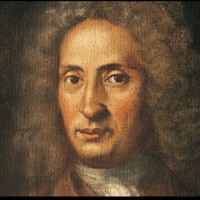
Giuseppe Torelli
Born: 1658Died: 1709
Education: Basilica di San Petronio in Bologna
Career: Accademia Filarmonica as suonatore di violino
Giuseppe Torelli was an Italian violist and violinist, pedagogue and composer, who ranks with Arcangelo Corelli among the developers of the Baroque concerto and concerto grosso. Not much is known about his early years, and it is not known with whom he studied violin though it has been speculated that he was a pupil of Leonardo Brugnoli or Bartolomeo Laurenti, and it has also been suggested that Giuliano Massaroti was one of Torelli's earliest teachers, owing to his close proximity in Verona. Torelli departed Verona in 1681 and shortly afterward may have taken the post as maestro di cappella at the Imola Cathedral in the Bologna province. An accomplished string player, he also began studying composition with Giacomo Antonio Perti around this time. On June 27, 1684, at the age of 26, Giuseppe Torelli became a member of the Accademia Filarmonica as suonatore di violino. He was active in the orchestra of the huge Basilica di San Petronio in Bologna from 1686 to 1695 as a violist. His first published works were the ten Sonate a 3, for violin and basso continuo, and 12 Concerto da camera for two violins and basso continuo. Both appeared in 1686, and were probably written shortly after his arrival in Bologna. In 1687, Torelli published his third collection of works, this one a set of 12 Sinfonie, for two to four instruments. His next (1688) was the 12 Concertino per camera, for violin and cello. Around 1690 Torelli began writing his first trumpet works, the Suonata con stromenti e tromba. The composer's growing interest in the trumpet, unusual for a string player, likely owed something to the virtuoso trumpeter Giovanni Pellegrino Brandi, who occasionally performed with the San Petronio orchestra, of which Torelli was a member. In 1692 Giuseppe Torelli published another collection of works, the Sinfonie a 3 e concerti a 4. Four years later he departed Bologna, eventually reaching Ansbach, Germany, where he engaged in some joint musical ventures with his friend, Pistocchi, the famous castrato and composer. There are accounts that during this time, Torelli toured Germany with Pistocchi. Torelli was appointed maestro di concerto in Ansbach, probably in 1697. It appears that during his tenure there, he wrote very little music, apparently finding the duties demanding. The composer was known to suffer from hypochondria in his later years, and the condition may well have been worsening for him while away from home. By 1698 Giuseppe Torelli was maestro di concerto at the court of Georg Friedrich II, Margrave of Brandenburg-Ansbach, where his Concerti musicali a quattro, Op. 6 were published. He conducted there the orchestra for Le pazzie d'amore e dell'interesse, an idea drammatica composed by the maestro di cappella, the castrato Francesco Antonio Pistocchi, before leaving for Vienna in December 1699. He returned to Bologna sometime before February (1701), when he is listed as a violinist in the newly re-formed cappella musicale at San Petronio, directed by his former composition teacher Perti. Torelli and Pistocchi seem to have appeared in a number of concerts together in the early 1700's, most likely earning substantial fees. Relatively little is known about Torelli in his final years, except that he composed little music. His only significant effort was the 12 Concerti grossi con una pastorale, Op. 8, which features one of his more popular pieces, the so-called Christmas Eve Concerto (No. 6). Giuseppe Torelli died in Bologna in 1709, where his manuscripts are conserved in the San Petronio archives. Giuseppe's brother, Felice Torelli, was a Bolognese painter of modest reputation, who went on to be a founding member of the Accademia Clementina. The most notable amongst Giuseppe's many pupils was Francesco Manfredini. Giuseppe Torelli's music served as an essential link in the evolution of the concerto grosso and and the solo concerto, for strings and continuo forms. He was also the most prolific Italian composer for the trumpet, with some three dozen pieces, variously entitled sonata, sinfonia, or concerto, for one, two, or four trumpets. His works were published in eight collections of concertos, sinfonias, and sonatas, all appearing chronologically. Thus, one can trace his progress from the rather conventional style of the early chamber-oriented concertos and sonatas to the more expansive and stronger efforts of the middle sets. The last two of his collections, 12 Concerti musicali and 12 Concerti grossi con una pastorale are the flowering of his efforts in the these genres. The Concerti musicali are more deftly written than his previous efforts, with ritornellos taking a more prominent role, while the Concerti grossi show his full grasp of structure and a crucial balancing of the roles of the soloist and the orchestral players. Apart from the published collections many other works (sinfonias, concertos, sonatas, etc.) remain in manuscript.

